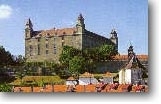 |
| http://www.slovakia.org/ |
Since Slovakia separated from Czechoslovakia in 1993, tourism and international attention have grown. But this small country nestled inside the heart of Eastern Europe, bordering Austria and Poland, has a vast and rich history that extends long before 1993.
Despite its size, Slovakia—whose real name is the Slovak Republic, though either moniker is acceptable—abounds in culture.
The country boasts a rich folk tradition. Centuries of cultural repression and control by foreign governments have influenced much of Slovakia's art, literature, and music. Examples of folk architecture, such as wooden churches and brightly painted houses, are found throughout the country, particularly in Eastern Slovakia.
Traditional Slovakian music is one of the most original of Slavic and European folklore. Its oldest form is from the time of Great Moravia (9th century). Today, music still plays a vital part in the land's culture. Some of the most renown orchestras are The Philharmonic Orchestra of Bratislava and Kosice, The Symphonic Orchestra of Bratislava Broadcast and The Slovak Chamber Orchestra.
There are 12 state scientific libraries in Slovakia, 473 libraries affiliated with universities and institutions of higher learning, and 2,600 public libraries. Slovakia is also home to more than 50 museums, such as the Slovak National Museum (founded in 1893) in Bratislava and the Museum of Eastern Slovakia (1872) in Kosice.
Throughout its history, Slovakia has produced numerous heroes in many areas, from art to literature, from humanitarian work to religion. The following is a compilation of some of the country's best known heroic figures:
Juraj Janosik is known as the Slovak Robin Hood. In the 1700s, he was the captain of a gang of robbers that took justice into their own hands by distributing money and goods from the aristocracy and giving them to the poor people. In 1713, historical records show Janosik was captured, imprisoned, and hung by a local court. Despite his early and savage death, his legend has survived, thrived, and become a huge factor in Slovak folk history to this day.
It all began in 1688 when Janosik was born in Terchova. During the Rakoczi uprising in the early 1700s, Janosik served in the insurrectionist army and then the emperor's troops. While in the Habsburg army, Janosik was introduced to a gang leader named Tomas Uhorcik, who eventually made Janosik captain of the robbers. The group took from noblemen, landowners, merchants and travelers and gave to those less fortunate.
After repeated captures and escapes. Janosik was finally jailed and given a death sentence. He was just 25 years old when he was hanged.
His legend was already expanding in the early 18th century, mainly because Janosik was considered a symbol of rebellion against the establishment. Aside from inspiring countless artists, his story was a key element during the Slovak national revival. Throughout the years, people needed a hero, especially one who took from the rich and gave to the poor. As the story evolved, so did Janosik's abilities. In time, the tales listed him as invincible, protected from even bullets.
One reason Janosik became such a hero: he wasn't a typical thug. He didn't rob the rich, only took things away. The tales of Janosik and his pal, Uhorcik, involve everything that makes a good legend: love, adventure, early death, martyrdom, and fighting for justice.
For a detailed account of the life of Janosik, visit http://www.tivolifilm.hu/works/janosik/.
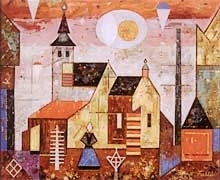 |
| Fulla's painting, "Sun Over Church," Courtesy of SNG and the Slovak Spectator newspaper |
Artists
Without such great historical legends as inspiration, how could artists create brilliant books, plays and paintings? Slovakia has numerous artists who have enriched the world with their talents.
One of the most significant modern artists, Ludovit Fulla, is seen as founder of Slovak modernism.
"He was the only Slovak modernist who was able to incorporate and interpret folk art elements into the progressive thinking of European avant-garde," said Katarina Cierna, the curator of the Fulla and Folk Art Exhibition, in an interview with www.slovakradio.sk.
He depicted Slovakia as a central theme in his artwork, meshing myth with reality. He played with lines, transforming realistic shapes into geometrical patterns and turning many pictures into dream-like visions. Fulla was a master at incorporating and interpreting folk art elements into his own perception of what he was painting. In this way, he represents features of the European avant-garde movement.
In his work, viewers can see the influence of Kandinsky, Chagall, Picasso and Klee. His abstract, geometrical shapes reflect Vassily Kandinsky, while his flying people in a dream-like setting is very much like the works of Marc Chagall. The play of lines turning into art shows the touch of Paul Klee.
Fulla was born in the Liptov region in 1902 and his grandparents came from rural Orava. Experts say this blending of regions helped him experience different cultures, folk costumes and ways of non-urban living—views which eventually influenced his artwork. Since the 1920s, Fulla's repeated folklorist motifs included brides and grooms and the legendary Slovak hero, Jánosík. He was known to be fascinated by the folk costumes worn by the villagers in the vicinity of Ruzomberok, North East Slovakia. The villagers of Liptovske Sliace, with their embroidered costumes, especially drew his attention. Fulla painted in bright colors like orange and the traditional color of Slovak folkore: red.
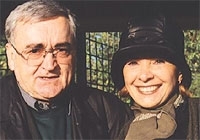 |
| Stanislav Stepka and Kamila Magalova. From the UNICEF Slovakia website |
One of the Slovak Republic's greatest entertainers is Stanislav Stepka, a playwright, actor and screenplay author.
Stepka was born July 26, 1944, in Radosina. He went on to study at the Pedagogical Faculty in Nitra and later at Comenius University in Bratislava. He worked as a teacher, reporter and an editor. In 1983, he began his professional career of playwriting. But he wrote plays long before then.
Since 1963, Stepka has written 36 theater plays and all were staged by Radosinské Naivné Divadlo (RND). Stepka acted in all of the plays and directed most of them. His play, Jaaanosiiik (1970), was staged 500 times and has become the most successful original theater play in Slovakia.
Other well-known plays by Stepka include Clovecina, Slovenske Tango, Pavilón B, Zenske Oddelenie, Ako Som Vstupil Do Seba, and Nevesta Predana Kubovi.
Most of his works fall into the genre of literary cabaret. They're written in standard Slovak and in his native Radosina dialect. Stepka's works have been translated into English, French, Italian, Hungarian and a number of Slavic languages.
Slovakia has also given the world many fine on-screen talents, such as Kamila Magalova. This popular actress and member of the Slovak National Theatre works with the Slovak Committee for UNICEF, alongside Stanislav Stepka. Through her high-profile work and charity performances, Magalova and the other cinema greats help raise public awareness about UNICEF and children's rights.
Magalova was born November 15, 1950, in Bratislava. Some of her films on the big and small screens include Vystrel na Bonaparta, Maria Stuarda, Falosny Princ, Gulocky, and Americka Tragedia.
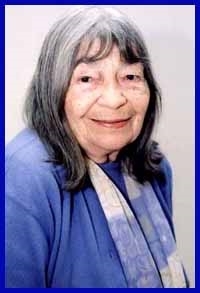 |
| Edith Drori, from www.yad-vashem.org.il |
Faith and Freedom
The Slovak Republic boasts of numerous freedom fighters, such as Edith Drori and Vasil' Hopko.
One of Slovakia's freedom fighters was Edith Drori. Born in 1920 in Dunaharaszti, Hungary, Drori became part of the anti-Nazi underground movement during World War II. In 1941, Drori's older brother was sent to a labor camp after Germany invaded the Soviet Union. Following rumors that women would be sent away for forced labor, Drori left her mother and fled to a nearby village. When she returned, Drori learned that her mother had been sent to her death. In a fit of despair, Drori decided to turn herself into the Slovakian police, but was talked out of it after a chance meeting with a former acquaintance altered her plans.
So instead, she headed off to a small town in the Sitno Mountains where she joined up with a few other people to form a small underground cell that would print a newsletter calling for an end to Jewish persecution.
After the group disbanded, Drori joined the Slovakian revolt in 1944. She moved to the Brigade to Free the Slavs and served as a liaison between the Slovakian popular front and the underground. She was the only female among 200 fighters.
When the Germans suppressed the revolt, Drori fled and reunited with her first underground group to hide from the Germans. But after months in the forest, Drori became extremely ill with malaria and spent a month in a Romanian military hospital after the Russians liberated the nation.
At the end of the war, Drori was awarded the Red Star Medal of High Merit and a medal as a heroine of the Slovakian people.
In 1952, she married Shlomo Drori and later adopted a daughter.
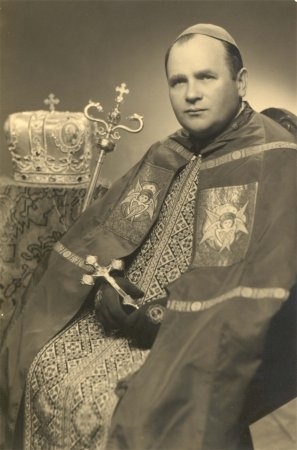 |
| Vasil' Hopko, from http://www.vatican.va |
One Slovak Republic faith-based hero is Vasil' Hopko. He was born on April 21, 1904, in Hrabské, a small village in Eastern Slovakia. Raised by his uncle, a Greek-Catholic priest, Hopko felt called to the priesthood at an early age. In 1929, he was ordained a priest at the Greek-Catholic Seminary of Presov. He went on to work with youth, elderly, unemployed and orphans in Prague. He founded both the Movement of Greek-Catholic Students and the Greek-Catholic Youth Union.
In 1936, Hopko returned to Slovakia where he served as spiritual leader in the Greek-Catholic Seminary of Presov. He was appointed as secretary of the Bishop's Curia, wrote/published various works, and became the first editor of the magazine Blahovistnik (The Gospel Messenger).
After WWII, the atheist influence took over and the bishop appointed Hopko as an auxiliary bishop to help defend against the attacks on the Greek-Catholics. The Czechoslovakian Communist Party prepared for the elimination of the Greek-Catholic Church in its nation. On April 28, 1950, the Communists declared that the Greek-Catholic Church of Czechoslovakia no longer existed and that all its priests, followers and churches were to be transferred over to the Orthodox Church. Bishop Hopko was arrested.
Hopko was inhumanely interrogated and tortured in hopes that he would deny his faith and his calling. After a year of this, he was condemned to 15 years in prison and stripped of his civil rights. While in prison, reports state that Hopko was slowly poisoned with arsenic.
In 1964, he was released from prison for health reasons, having suffered from grave illnesses and depression. But he still continued to resurrect the Greek-Catholic Church, which was reestablished on June 13, 1968, after 18 years of persecution. That same year, Pope Paul VI confirmed Hopko as Auxiliary Bishop for all Greek-Catholic faithful in Czechoslovakia. He died eight years later in July of 1978.
Literature
This region of the world is home to dozens of literary heroes, such as:
Jan Holly 1785-1849 Known mainly for his amazing poetry, Jan Holly is called the Dante of Slovak literature as well as the father of Slovakian poetry. From 1824 to 1846, this Slovak writer created epic and idyllic poems embracing Slovak ancient history. His best known book is called Svatopluk.
Ludovit Stur 1815-1856 Ludovit Stur was a poetically styled writer and intellectual leader in Slovakia. Being concerned with many Slav issues, he published many political essays and was regarded as a champion of Slovak culture. Songs and Poems is his best known work.
Josef Hurban 1817-1908 Josef Hurban, a Lutheran pastor, was anti-Magyar. He helped organize an uprising against the Hungarian rule in 1848. His most well-known literary work is The Patent-Medicine Salesman.
Michael Hodza 1811-1870 Michael Hodza, also a Lutheran pastor, took part in the uprising of 1848 just like his counterpart Hurban. His main contribution to Slovak literature was his work on developing the Slovak literary language.
Jan Botto 1829-1881 An innovative narrative poet, Jan Botto's The Death of Janosik is a well-known epic.
Milo Urban Milo Urban's The Living Whipis helped establish him as one of the premier Slovak writers; the work is considered one of the finest Slovak works of all time. He writes in the vivid style of literary realism.
Music
Slovakia also boasts of numerous great musicians, such as Alexander Moyzes(1906-1984).
He is considered one of the most significant figures in modern Slovak music. Moyzes, born into a musical family in Northern Slovakia, studied organ, conducting, and composition at the Prague Conservatory, where he graduated in 1929. The following year, he studied in the master class of Vítezslav Novák, who later directed his attention to Slovak music--the source of his inspiration.
The year he graduated, Moyzes was appointed to the teaching staff of the Music Academy in Bratislava, the Slovak capitol. He also spent a number of years as principal music advisor to Radio Bratislava. Later, he was appointed professor of composition at the Bratislava Music Academy, where he taught three generations of Slovak composers. His style of composition was Slovak in inspiration, yet utilized contemporary trends in European music.
Page created on 7/9/2004 1:00:25 PM
Last edited 7/9/2004 1:00:25 PM
